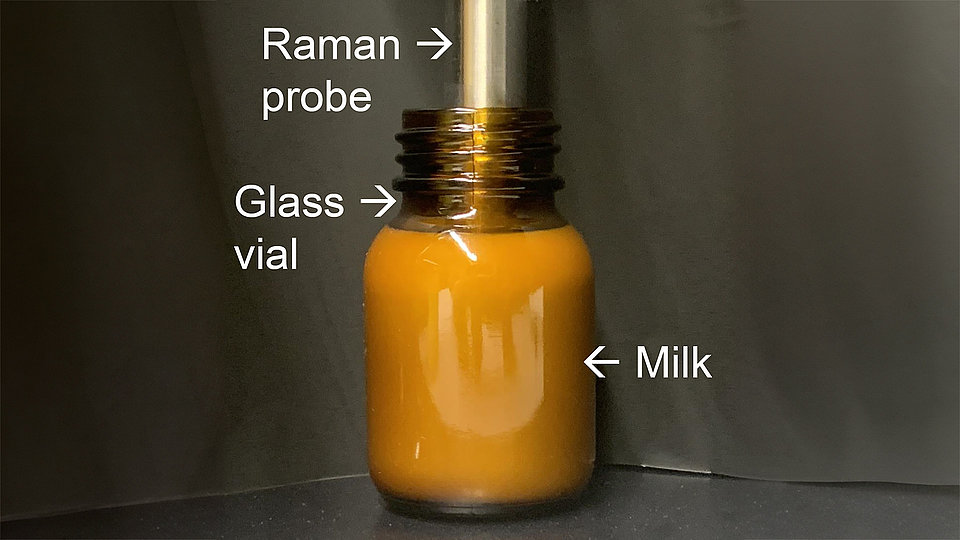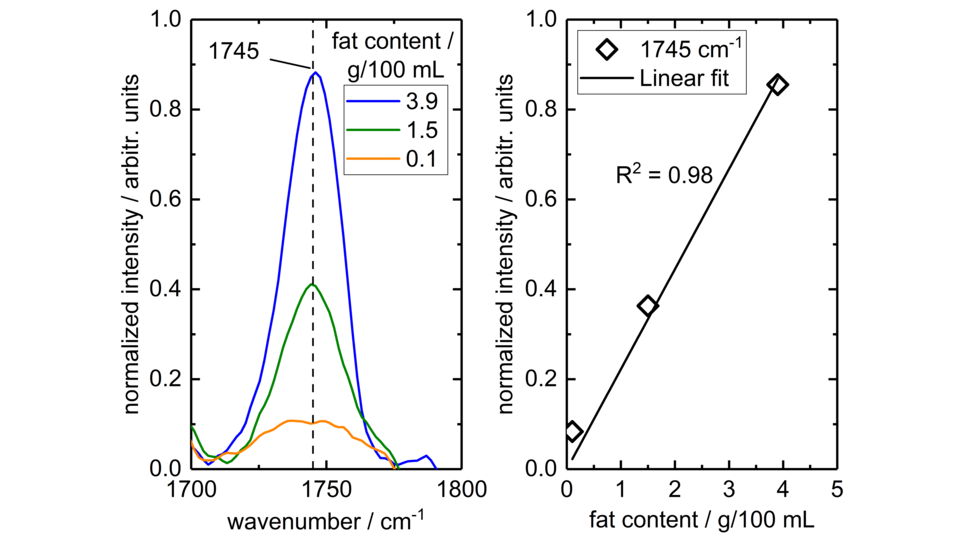Shifted Excitation Raman Difference Spectroscopy – pilot laboratory investigations for milk inspection
Fig. 1. Experimental arrangement for SERDS pilot investigations on bovine milk. The Raman probe head is directly immersed into the milk sample to conduct the measurements.
Fig. 2. Raman spectra excited at 783.63 nm and 784.29 nm (top) and SERDS spectrum (bottom) of bovine milk with 3.9 g/100 mL fat content measured with the portable Raman system. Numbers identify Raman signals of selected proteins and lipids. The Raman spectra are vertically offset for clarity.
The concept of smart farming, especially food monitoring along the entire supply chain (e.g., milk for the dairy industry), is of great interest in modern agricultural practice. Key goals include ensuring food quality, safety, and authenticity to prevent fraud. Raman spectroscopy is a particularly promising approach as it enables the non-destructive determination of a sample’s chemical composition. To effectively separate the characteristic Raman signals from background interferences, e.g., laser-induced fluorescence, ambient light, and fixed pattern noise, we applied Shifted Excitation Raman Difference Spectroscopy (SERDS) in our study. This technique uses two slightly shifted narrow-band laser excitation wavelengths to record two Raman spectra. While Raman signals follow the applied shift in wavelength, background interferences remain unaffected. By subtracting the two Raman spectra, the Raman signals can be separated from these background interferences.
The FBH developed and fabricated monolithic dual-wavelength diode lasers emitting at 785 nm, which are suitable as excitation light sources for Raman spectroscopy and SERDS. Their compact size allows integration into an in-house realized portable sensor system for on-site experiments.
SERDS pilot laboratory investigations were conducted using the above-mentioned portable sensor system and three selected bovine milk samples with fat contents of 0.1 g/100 mL, 1.5 g/100 mL, and 3.9 g/100 mL to address commercially relevant fat concentrations. As depicted in Fig. 1, the milk was filled into glass vials and the Raman probe head of the portable Raman system was directly immersed into the sample (ca. 50 mL) for the measurements.
Averaged Raman spectra of milk with 3.9 g/100 mL fat content, recorded at both excitation wavelengths with 35 mW optical output power at the sample, 30 accumulations, and 1 s exposure time for each Raman spectrum, are presented in Fig. 2 (top). These spectra enable to identify Raman signals from major milk components such as fat and proteins, with a vertical offset used for clarity. However, due to the presence of background interferences, weak Raman signals at 1005 cm-1 (protein) and 1745 cm-1 (fat) are difficult to evaluate. In the SERDS spectrum (Fig. 2, bottom), these Raman signals are effectively separated from disturbing interferences, such as background signals and fixed pattern noise, and can be clearly identified.
This enables a quantitative analysis of the milk fat content by normalizing the intensity on the protein Raman signal at 1005 cm-1 and determining the normalized net Raman signal intensity at, e.g., 1745 cm-1 that is specific to fat. A detailed view on the Raman signal at 1745 cm-1 for all three investigated fat contents is given in Fig. 3 (left), showing the expected variation in signal intensity. In the right part of Fig. 3, the SERDS net intensities at 1745 cm-1 are displayed against the fat content of the milk samples as stated by the manufacturer, along with a linear fit. Based on the evaluated Raman signal and applying the 3-sigma criterion, a limit of detection of about 0.1 g/100 mL fat content can be estimated.
The results demonstrate that SERDS shows a great potential for qualitative and quantitative milk analysis of major ingredients, e.g. to determine the milk fat content within seconds.
Publications
M. Maiwald, K. Sowoidnich, A. Müller, B. Sumpf, “Portable Shifted Excitation Raman Difference Spectroscopy for Agri-Photonics: From On-Site Precision Agriculture to Smart Farming”, Proc. SPIE, vol. 12879, Photonic Technologies in Plant and Agricultural Science, Photonics West, San Francisco, USA, Jan 27 - Feb 1, 1287907 (2024).
M. Maiwald, K. Sowoidnich, B. Sumpf, “Pilot investigations on solids, liquids and gases using a portable shifted excitation Raman difference spectroscopy sensor system”, Proc. SPIE, vol. 12396, Plasmonics in Biology and Medicine XX, Photonics West, San Francisco, USA, Jan 28 - Feb 3, 1239602 (2023).


